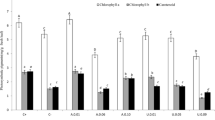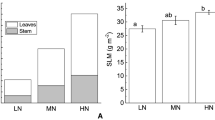Abstract
The responses of carbon and nitrogen metabolisms in the medical plant Catharanthus roseus to the nitrogen solutions (N1, N2 and N3) containing different ratio of nitrate to ammonium (1:0, N1; 1:1, N2; 1:3, N3) were investigated here. The plants in N3 nitrogen solution were strongly inhibited in photosynthetic gas exchange and carbohydrate accumulation, reflecting the toxicity symptom of excess ammonium continuously accumulated in plants. The treatment with N2 nitrogen solution, however, displayed an obviously synergistic effect on plant growth and metabolisms in contrast to nitrate as the sole source. The short-term (7 days) exposure of plants to N2 nitrogen solution resulted in an increased shoot/root ratio, leaf mass ratio, and Pn, as well as the elevated levels of sucrose, glutamate, aspartate, proline and threonine. The plants in N2 nitrogen solution accumulated twofold catharanthine and vinblastine than did the plants in N1 or N3 nitrogen solution after the long-term incubation. Internal nitrate had an increased accumulation in the plants in N2 nitrogen solution compared to the counterparts. The supply of N2 or N3 nitrogen solution to plants for 7 days induced an over tenfold increase of ammonium in leaves as compared to the case using N1 nitrogen solution. The increased ammonium ion promoted the activities of NADH-dependent glutamate dehydrogenase (NADH-GDH) both in the leaf and root of plants. Under the ammonium-containing solution (N2 and N3 nitrogen solutions), there was a significantly increased activity for glutamine synthase (GS) in the root during experiment and for nitrate reductase (NR) in the leaf and root only after 21 days of treatment. The performed correlation analysis revealed a negative relation between soluble sugars and internal ammonium, whereas a positive correlation of alkaloid production with glutamate and aspartate.





Similar content being viewed by others
References
Aslam M, Huffaker RC, Rains DW (1984) Early effects of salinity on nitrate assimilation in barley seedlings. Plant Physiol 76:321–325
Bialczyk J, Lechowski Z, Dziga D, Molenda K (2005) Carbohydrate and free amino acid contents in tomato plants grown in media with bicarbonate and nitrate or ammonium. Acta Physiol Plant 27:523–529
Britto DT, Kronzucker HJ (2002) NH4 + toxicity in higher plants: a critical review. J Plant Physiol 159:567–584
Britto DT, Siddiqi MY, Glass AD, Kronzucker HJ (2001) Futile transmembrane NH4(+) cycling: a cellular hypothesis to explain ammonium toxicity in plants. Proc Natl Acad Sci USA 98:4255–4258
Bryant JP, Chapin FS III, Klein DR (1983) Carbon/nutrient balance of boreal plants in relation to vertebrate herbivory. Oikos 40:357–368
Calatayud Á, Gorbe E, Roca D, Martínez PF (2008) Effect of two nutrient solution temperatures on nitrate uptake, nitrate reductase activity, NH4 + concentration and chlorophyll a fluorescence in rose plants. Environ Exp Bot 64:65–74
Campos-Tamayo F, Hernandez-Dominguez E, Vazquez-Flota F (2008) Vindoline formation in shoot cultures of Catharanthus roseus is synchronously activated with morphogenesis through the last biosynthetic step. Ann Bot 102:409–415
Chen SJ, Hung KT, Kao CH (1997) Ammonium accumulation is associated with senescence of rice leaves. Plant Growth Regul 21:195–201
Crawford NM (1995) Nitrate: nutrient and signal for plant growth. Plant Cell 7:859–868
De Luca V, St Pierre B (2000) The cell and developmental biology of alkaloid biosynthesis. Trends Plant Sci 5:168–173
Debouba M, Maaroufi-Dghimi H, Suzuki A, Ghorbel MH, Gouia H (2007) Changes in growth and activity of enzymes involved in nitrate reduction and ammonium assimilation in tomato seedlings in response to NaCl stress. Ann Bot 99:1143–1151
Forde BG (2002) Local and long-range signaling pathways regulating plant responses to nitrate. Annu Rev Plant Biol 53:203–224
Foyer CH, Parry M, Noctor G (2003) Markers and signals associated with nitrogen assimilation in higher plants. J Exp Bot 54:585–593
Fritz C, Mueller C, Matt P, Feil R, Stitt M (2006a) Impact of the C-N status on the amino acid profile in tobacco source leaves. Plant Cell Environ 29:2055–2076
Fritz C, Palacios-Rojas N, Feil R, Stitt M (2006b) Regulation of secondary metabolism by the carbon-nitrogen status in tobacco: nitrate inhibits large sectors of phenylpropanoid metabolism. Plant J 46:533–548
Garnica M, Houdusse F, Claude Yvin J, Garcia-Mina JM (2009) Nitrate supply induces changes in polyamine content and ethylene production in wheat plants grown with ammonium. J Plant Physiol 166:363–374
Geiger M, Haake V, Ludewig F, Sonnewald U, Stitt M (1999) The nitrate and ammonium nitrate supply have a major influence on the response of photosynthesis, carbon metabolism, nitrogen metabolism and growth to elevated carbon dioxide in tobacco. Plant Cell Environ 22:1177–1199
Gerendás J, Zhu Z, Bendixen R, Ratcliffe RG, Sattelmacher B (1997) Physiological and biochemical processes related to ammonium toxicity in higher plants. Zeitschrift für Pflanzenernährung und Bodenkunde 160:239–251
Glass AD, Britto DT, Kaiser BN, Kinghorn JR, Kronzucker HJ, Kumar A, Okamoto M, Rawat S, Siddiqi MY, Unkles SE, Vidmar JJ (2002) The regulation of nitrate and ammonium transport systems in plants. J Exp Bot 53:855–864
Grechi I, Vivin P, Hilbert G, Milin S, Robert T, Gaudillère JP (2007) Effect of light and nitrogen supply on internal C:N balance and control of root-to-shoot biomass allocation in grapevine. Environ Exp Bot 59:139–149
Kant S, Kant P, Lips H, Barak S (2007) Partial substitution of NO(3)(-) by NH(4)(+) fertilization increases ammonium assimilating enzyme activities and reduces the deleterious effects of salinity on the growth of barley. J Plant Physiol 164:303–311
Kronzucker HJ, Kirk GJD, Yaeesh Siddiqi M, Glass ADM (1998) Effects of hypoxia on 13NH4 + fluxes in rice roots. Plant Physiol 116:581–587
Lu B, Yuan Y, Zhang C, Ou J, Zhou W, Lin Q (2005) Modulation of key enzymes involved in ammonium assimilation and carbon metabolism by low temperature in rice (Oryza sativa L.) roots. Plant Sci 169:295–302
Majerowicz N, Kerbauy GB (2002) Effects of nitrogen forms on dry matter partitioning and nitrogen metabolism in two contrasting genotypes of Catasetum fimbriatum (Orchidaceae). Environ Exp Bot 47:249–258
Matraszek R (2008) Nitrate reductase activity of two leafy vegetables as affected by nickel and different nitrogen forms. Acta Physiol Plant 30:361–370
Matt P, Krapp A, Haake V, Mock HP, Stitt M (2002) Decreased Rubisco activity leads to dramatic changes of nitrate metabolism, amino acid metabolism and the levels of phenylpropanoids and nicotine in tobacco antisense RBCS transformants. Plant J 30:663–677
Qian X, Shen Q, Xu G, Wang J, Zhou M (2004) Nitrogen form effects on yield and nitrogen uptake of rice crop grown in aerobic soil. J Plant Nutrition 27:1061–1076
Raab TK, Terry N (1994) Nitrogen source regulation of growth and photosynthesis in Beta vulgaris L. Plant Physiol 105:1159–1166
Raab TK, Terry N (1995) Carbon, nitrogen, and nutrient interactions in Beta vulgaris L. as Influenced by Nitrogen Source, NO3 − versus NH4 +. Plant Physiol 107:575–585
Ruan J, Gerendas J, Hardter R, Sattelmacher B (2007) Effect of nitrogen form and root-zone pH on growth and nitrogen uptake of tea (Camellia sinensis) plants. Ann Bot 99:301–310
Savvas D, Karagianni V, Kotsiras A, Demopoulos V, Karkamisi I, Pakou P (2003) Interactions between ammonium and pH of the nutrient solution supplied to gerbera (Gerbera jamesonii) grown in pumice. Plant Soil 254:393–402
Scheible WR, Gonzalez-Fontes A, Lauerer M, Muller-Rober B, Caboche M, Stitt M (1997a) Nitrate acts as a signal to induce organic acid metabolism and repress starch metabolism in tobacco. Plant Cell 9:783–798
Scheible WR, Lauerer M, Schulze E-D, Caboche M, Stitt M (1997b) Accumulation of nitrate in the shoot acts as a signal to regulate shoot-root allocation in tobacco. The Plant J 11:671–691
Schortemeyer M, Stamp P, Feil B (1997) Ammonium Tolerance and Carbohydrate Status in Maize Cultivars. Ann Bot 79:25–30
Skopelitis DS, Paranychianakis NV, Paschalidis KA, Pliakonis ED, Delis ID, Yakoumakis DI, Kouvarakis A, Papadakis AK, Stephanou EG, Roubelakis-Angelakis KA (2006) Abiotic stress generates ROS that signal expression of anionic glutamate dehydrogenases to form glutamate for proline synthesis in tobacco and grapevine. Plant Cell 18:2767–2781
Smith AM, Stitt M (2007) Coordination of carbon supply and plant growth. Plant Cell Environ 30:1126–1149
St-Pierre B, Vazquez-Flota FA, De Luca V (1999) Multicellular compartmentation of catharanthus roseus alkaloid biosynthesis predicts intercellular translocation of a pathway intermediate. Plant Cell 11:887–900
Tabatabaei SJ, Yusefi M, Hajiloo J (2008) Effects of shading and NO3:NH4 ratio on the yield, quality and N metabolism in strawberry. Sci Hortic 116:264–272
Tang ZH, Liu YJ, Guo XR, Zu YG (2011) The combined effects of salinity and nitrogen forms on Catharanthus roseus: The role of internal ammonium and free amino acids during salt stress. J Plant Nutr Soil Sci 174:135–144
Tschoep H, Gibon Y, Carillo P, Armengaud P, Szecowka M, Nunes-Nesi A, Fernie AR, Koehl K, Stitt M (2009) Adjustment of growth and central metabolism to a mild but sustained nitrogen-limitation in Arabidopsis. Plant Cell Environ 32:300–318
Walter A, Schurr U (2005) Dynamics of leaf and root growth: endogenous control versus environmental impact. Ann Bot 95:891–900
Acknowledgments
We sincerely thank David Lawlor for constructive comments and suggestions on the manuscript preparation and revision. This study was financially supported by the National Natural Science Foundation of China (31000176) and the Fundamental Research Funds for the Central Universities (DL09BA34).
Author information
Authors and Affiliations
Corresponding author
Additional information
Communicated by L. Bavaresco.
Rights and permissions
About this article
Cite this article
Guo, XR., Zu, YG. & Tang, ZH. Physiological responses of Catharanthus roseus to different nitrogen forms. Acta Physiol Plant 34, 589–598 (2012). https://doi.org/10.1007/s11738-011-0859-9
Received:
Revised:
Accepted:
Published:
Issue Date:
DOI: https://doi.org/10.1007/s11738-011-0859-9




